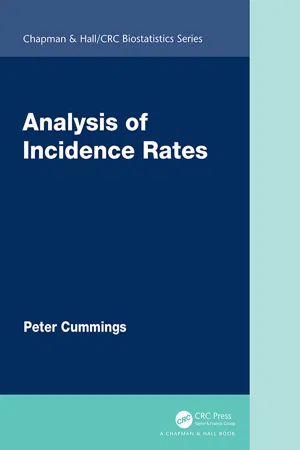Social Sciences
Death Rates
Death rates refer to the number of deaths occurring in a specific population over a given period of time, often expressed as a rate per 1,000 or 100,000 individuals. They are a key measure in understanding the health and well-being of a population, and are used to assess the impact of diseases, accidents, and other factors on mortality within a community.
Written by Perlego with AI-assistance
Related key terms
6 Key excerpts on "Death Rates"
- eBook - ePub
Population Geography
A Systematic Exposition
- Mohammad Izhar Hassan(Author)
- 2020(Publication Date)
- Routledge India(Publisher)
11 Mortality and life tableMortality, or the occurrence of death, is another component of population change. Unlike fertility, mortality is more stable and predictable, and is less prone to unique fluctuations. While fertility behaviour of a population depends on a set of social, demographic, psychological and economic factors, mortality is a biological phenomenon. Death control is universally acceptable in all societies of the world. The Death Rates have, therefore, undergone a more rapid decline than that of the birth rates. It is this decline in the Death Rates, rather than any increase in the birth rates, which has been responsible for rapid growth in the world population during the recent past. Temporal changes in Death Rates not only affect the size of a population but also its age composition, which has important bearings on the social, economic and demographic conditions in an area. The study of mortality is, therefore, useful for analysing the current demographic conditions as well as for determining the prospect of potential change in the mortality conditions in the future. The analysis of mortality is of vital importance to planners and policy makers in the provision of basic health care services in any population. The analytical study of mortality can be described as the study of ‘the risk of dying’ in different populations or different groups in a population.The meaning of the term ‘death’ does not involve any ambiguity and, therefore, it facilitates the measurement of mortality. The UN and WHO have defined the term as ‘the permanent disappearance of all evidence of life at any time after birth’.The vital registration or civil registration system provides data on deaths in a country. However, in a country where such registration system is absent or inadequate, statistics on mortality are obtained from periodic censuses and sample surveys. It should, however, be noted that periodic censuses do not provide data on mortality directly. Estimates on mortality are indirectly derived using the age-sex distribution of population of two consecutive censuses. In sample surveys, however, when a direct question on the occurrence on deaths is included estimates on mortality are available. - Peter J. Fos, David J. Fine, Miguel A. Zúniga(Authors)
- 2018(Publication Date)
- Jossey-Bass(Publisher)
The fundamental measure of disease and death frequency is the rate. Rates differ from absolute counts in that they measure the occurrence of a disease or condition relative to a specific population and during a specified period of time. Rates are used to make comparisons among and across populations and can illustrate differences among and within populations. Rates are the basic units of comparison in terms of morbidity and mortality. A rate is similar to a ratio and is defined as follows:The numerator of a rate consists of the cases (or deaths) that are determined from routinely collected data (secondary data) or from specifically designed studies (primary data). Denominators of rates are usually the total number of individuals in a population. A common source of population numbers is the estimated population provided by the U.S. Census. Other denominator sources, which can be more accurately determined, include military, school, industrial, or health plan enrollment populations.Rates are expressed in many forms. They may be expressed as a percentage, or as numbers per 1,000 or per 100,000 individuals in a population. The form selected depends on convention or the magnitude of population numbers. Fractions are not typically expressed, because it is difficult to understand what is meant by 0.7 cases per 1,000; a more customary form would be to present a rate of 70 cases per 100,000. Several rates have characteristic formats. For example, infant and neonatal mortality rates are expressed as the rate per 1,000 live births. Birth and Death Rates are presented per 100,000 individuals in a population. Age‐specific and cause‐specific Death Rates are expressed as the rate per 100,000 population.Table 3.3- eBook - ePub
Applied Demography
An Introduction To Basic Concepts, Methods, And Data
- Steve H. Murdock(Author)
- 2019(Publication Date)
- Routledge(Publisher)
First, the term population tends to be used to refer to aggregate characteristics of a population living in an area; that is, to characteristics that are descriptive of the population but not necessarily of any given individual within the population. For example, a population's death rate is not reducible to the individuals within the population. That is, any given person in an area is either alive or dead at a given point in time; he or she has no death rate. On the other hand, a population's death rate is the aggregate effect of all deaths in the population. A death rate is thus uniquely an aggregate rather than an individualistic measure.A second aspect of the concept of population as used in demography (and in statistics) is that it is used to refer to all of the persons rather than to simply some (a sample) of the persons in an area. Demographers often refer to a subgroup of a total population as the population of persons with certain characteristics (e.g., the population of females, the population of black residents), but when the term population is used, the emphasis is generally on the total, the sum total of, persons within an area.Subpopulations and Cohorts
Persons using demographic data often also refer to subpopulations such as the old, the young, blacks, whites, Hispanics, the baby boomers, and similar groups. Any population group in a specified area composed of persons with one or more common characteristics can be referred to as a subpopulation. The concept of a cohort is more specific and refers to a group of persons with the common characteristic of being born during the same period of time. Members of a cohort may have other common characteristics (e.g., they may be males or females, black, Hispanic, white), but they will always be persons of similar ages. In addition, it should be recognized that the cohort is a concept used in a very unique way in the social sciences (Glenn, 1977). It tends to refer not only to the possession of a common biological age, but also to the fact that persons in any given cohort are passing through the life cycle exposed to certain similar effects.Cohort connotes not only birth during a specified period, but commonality resulting from the fad that its members have been socialized during a period of time with specific socioeconomic and historical events that are likely to cause them to exhibit similar behaviors and have similar perspectives. - eBook - ePub
Britain's Population
Demographic Issues in Contemporary Society
- Steven Jackson(Author)
- 2013(Publication Date)
- Routledge(Publisher)
Measurements of mortality indicate the rate at which people are dying in a population. As with fertility, there are a number of statistical techniques which can be applied to identify the significance of deaths in relation to the structure of the population. In Britain the chances of dying are largely determined by age. In 1990 81 per cent of deaths in England and Wales were of people aged 65 and above (OPCS 1991b), the most common causes of death being heart disease, respiratory diseases and cancer.The crude death rate, like the crude birth rate, is the simplest measure. The total number of deaths is expressed as a proportion of the mid-year estimates of population size. Also like the crude birth rate, this is an unreliable measure because it varies not only with the number of deaths but also with the age and sex distribution of the population. The greater the proportion of a population in the more elderly categories, the greater the apparent level of mortality. Age/sex-specific mortality rates can be calculated and provide a more precise indication of the level of mortality within a population. They present a profile of mortality experience across the life-span (Figure 3.6 ).Figure 3.6 Age/sex mortality rates 1994Source: Population Trends 88, table 13Age/sex-specific mortality rates can be used to iron out differences in population structure when comparing the mortality of different localities. The summary statistic which is normally applied is the standardized mortality ratio (SMR). This is ‘the ratio of the observed number of deaths in the area to the number expected if the age/sex-specific Death Rates in the standard population (i.e. for England and Wales) applied to the population of the local area’ (OPCS 1990: 13). It indicates the deviation of local mortality experience from the national norm and is usually expressed as a percentage rounded to the nearest whole number. Figure 3.7 - eBook - ePub
- Alan Clarke(Author)
- 2013(Publication Date)
- Routledge(Publisher)
Differentials in mortality rates and ratios by occupational class or socioeconomic grouping are more marked for some causes of death than others. Using data for men and married women, Marmot and McDowall (1986) conducted a study of adult mortality rates for specific causes of death. Their findings showed that in the early 1980s the disease-specific SMRs were consistently higher for manual workers: non-manual workers had a lower risk of death than manual workers. For example, for men in the 20 to 64 year age group, the SMRs for lung cancer for non-manual and manual workers were 65 and 129 respectively. In the same age group the manual classes also showed an above average SMR for coronary heart disease, 114 compared to 87 for the non-manual group. These findings suggest that as regards some major diseases the manual working classes are affected more than the non-manual middle classes. Whitehead (1988) makes the point that diseases which have often been associated with affluence or ‘executive stress’, such as coronary heart disease, appear to be more common in the manual classes. The significance of the influence of wider social factors and economic circumstances on mortality rates is indicated when she states, ‘Clearly in this country nowadays “diseases of affluence” have all but disappeared and what is left is a general health disadvantage of the poor’ (Whitehead, 1988, p. 232).Social inequalities in mortality are also evident in more recent studies of cause-specific deaths using the NS-SEC to ascertain social class (White et al., 2008). Table 4.4 presents the age-standardised mortality rates for men aged between 25 and 64 years. This shows that across all major causes of death the mortality rates in both the higher managerial/professional class and the intermediate class were lower than the average for all men in England and Wales. The findings also reveal evidence of a continuation of an inverse social class gradient for a number of causes of death.Table 4.4 Age standardised-mortality rates1 for selected causes by NS-SEC, men aged 25–64, England and Wales, 2001–20031 Directly age-standardised rate using the European standard population, quoted per million population.Source: White et al., 2008While Death Rates have declined substantially in all social classes, the sharpest falls have occurred in the non-manual classes. This has led to an overall widening of social class differences in mortality. As far as major causes of death are concerned, the largest ratios of mortality rates between the most and least disadvantaged social groups have been found for ischaemic heart disease, lung cancer, liver diseases and chronic lower respiratory diseases.Social class and morbidityAs can be seen from the above, patterns and trends in mortality rates are a reflection of a relationship between socio-economic status and inequalities in health. However, it is not only longevity that is of importance but the whole-life health experience. Indeed, as observed by Blaxter, ‘[i]nequalities in health may not be the same as inequalities in death’ (Blaxter, 1990, p. 7). In other words, ill health is not only studied in relation to mortality rates but can itself provide a useful measure of health status. Given that people are now living longer and mortality rates in the early and middle years are generally low, state of health is considered to be a more significant indicator of inequality than Death Rates. As noted at the beginning of this chapter, health expectancies can be measured not simply in terms of the length of life but also in relation to the health-related quality of life. Measures based on self-reported healthy life expectancy and disability-free life expectancy can be used to monitor changes in the nation’s health. By using data collected by the GHS and HSE it is possible to establish chronic and acute sickness rates for various groups in the population. - eBook - ePub
- Peter Cummings(Author)
- 2019(Publication Date)
- Chapman and Hall/CRC(Publisher)
22.1 What Is a Rate?The word rate is used in many ways. Most rates are counts divided by a denominator. But the choice of numerator and denominator affects both interpretation and method of analysis. The word rate is often applied to proportions; a count divided by another count. I will give little attention to rates that are proportions and after this chapter I will try not to call these rates. This book is mostly about event rates; counts of new events divided by person-time. In the epidemiology literature these are called incidence rates meaning that the numerator is a count of incident (new) events. This book will discuss incidence rates for events that are nonrecurrent, such as death, first onset of prostate cancer, or first time in prison, and rates of recurrent events, such as the number of falls, asthma attacks, or bankruptcies experienced by individuals.2.2 Closed and Open PopulationsRates are measures of event frequency. If someone says there were 400 homicides, it is natural for us to wonder what population experienced these events, how large was the population, and when did the events occur. It is useful to distinguish between closed and open populations (Greenland and Rothman 2008d pp36–39, Weiss and Koepsell 2014 pp17–19).A closed population is one in which all members are identified at the same time or something close to that ideal. Once all members are known, no new persons can join the population. Members can leave the population only when the planned observation period is over or they have the outcome of interest to the study. All people who graduated from Yale University in May 2008 may be considered members of a closed population. Another example is a clinical study in which everyone is enrolled on the same day and all are followed for a short period to some endpoint, without any lost to follow-up. The persons who boarded the Titanic
Learn about this page
Index pages curate the most relevant extracts from our library of academic textbooks. They’ve been created using an in-house natural language model (NLM), each adding context and meaning to key research topics.





